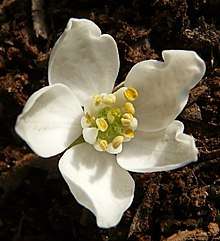Choisya
Choisya /ˈʃɔɪziə/[2] is a small genus of aromatic evergreen shrubs in the rue family, Rutaceae. Members of the genus are commonly known as Mexican orange due to the similarity of their flowers with those of the closely related orange, both in shape and scent. They are native to southern North America, from Arizona, New Mexico, Texas and south through most of Mexico. In its generic name Humboldt and Bonpland honoured Swiss botanist Jacques Denis Choisy (1799–1859).[3]
| Choisya | |
|---|---|
| Choisya ternata | |
| Scientific classification | |
| Kingdom: | Plantae |
| Clade: | Tracheophytes |
| Clade: | Angiosperms |
| Clade: | Eudicots |
| Clade: | Rosids |
| Order: | Sapindales |
| Family: | Rutaceae |
| Genus: | Choisya Kunth[1] |
| Species | |
| Synonyms[1] | |

Description
The species grow to 1–3 m (3.3–9.8 ft) tall. The leaves are opposite, leathery, glossy, palmately compound with 3-13 leaflets, each leaflet 3–8 cm (1.2–3.1 in) long and 0.5–3.5 cm (0.20–1.38 in) broad. C. ternata has three broad leaflets, while C. dumosa has up to 13 very narrow leaflets. The flowers are star-shaped, 3–5 cm (1.2–2.0 in) diameter, with 4-7 white petals, 8-15 stamens and a green stigma; they are produced throughout the late spring and summer. The fruit is a leathery two to six sectioned capsule.
Uses
Choisya species are popular ornamental plants in areas with mild winters, grown primarily for their abundant and fragrant flowers. The foliage is also aromatic, smelling of rue when bruised or cut. The flowers are also valued for honeybee forage, producing abundant nectar.
The following cultivars have gained the Royal Horticultural Society's Award of Garden Merit:-
Chemistry
Many quinoline alkaloids have been isolated from leaves of Choisya ternata.[8] C. ternata contains an alkaloid (ternanthranin), a volatile simple anthranilate that can be considered responsible for the antinociceptive activity of the crude plant extracts.[9]
Species
Pests and diseases
Choisya can be prone to attack by pythium root rot, particularly when propagated and grown in pots for the horticultural trade. In north-west Europe the main pest is snails, which eat the bark of even mature specimens, resulting in minor die-back of branches where ring-barking has occurred.
References
- "Genus: Choisya Kunth". Germplasm Resources Information Network. United States Department of Agriculture. 2008-03-21. Archived from the original on 2012-10-07. Retrieved 2009-09-27.
- Sunset Western Garden Book, 1995:606–607
But /ˈtʃɔɪziə/ or /ˈʃwɑːziə/ per the OED: "Choisya". Oxford English Dictionary (3rd ed.). Oxford University Press. September 2005. (Subscription or UK public library membership required.) - Gledhill, D. (2008). The Names of Plants (4 ed.). Cambridge University Press. p. 105. ISBN 978-0-521-86645-3.
- "Choisya × dewitteana 'Aztec Pearl'". RHS. Retrieved 12 April 2020.
- "Choisya × dewitteana White Dazzler = 'Londaz'". RHS. Retrieved 12 April 2020.
- "Choisya ternata". RHS. Retrieved 12 April 2020.
- "Choisya ternata 'Sundance = 'Lich'". RHS. Retrieved 12 April 2020.
- Boyd D.R., Sharma N.D., Loke P.L., Malone J.F., McRoberts W.C., Hamilton J.T.G."Synthesis, structure and stereochemistry of quinoline alkaloids from Choisya ternata", Organic and Biomolecular Chemistry 2007 5:18 (2983-2991)
- Radulović NS, Miltojević AB, McDermott M, Waldren S, Parnell JA, Pinheiro MM, Fernandes PD, de Sousa Menezes F." Identification of a new antinociceptive alkaloid isopropyl N-methylanthranilate from the essential oil of Choisya ternata Kunth.",J Ethnopharmacol. 2011 Mar 21.
- "GRIN Species Records of Choisya". Germplasm Resources Information Network. United States Department of Agriculture. Archived from the original on 2000-11-01. Retrieved 2010-09-27.
- "Choisya". Integrated Taxonomic Information System. Retrieved 2010-09-27.
![]()